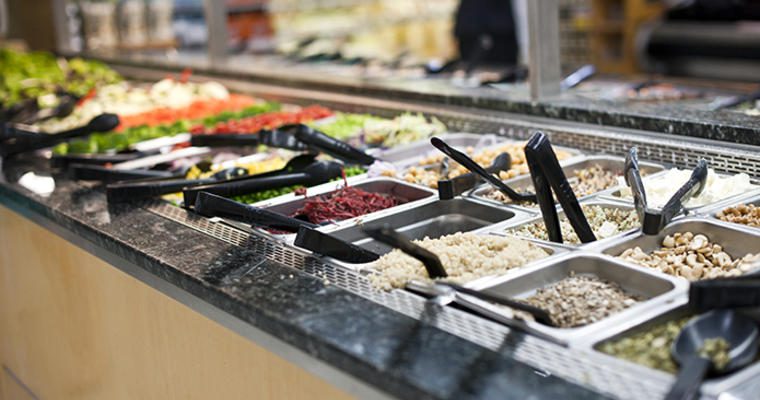The benefits are clear. A salad or hot food bar promotes consumption of fresh and healthy foods people feel good about eating. Consumers can fill plates by choosing from many options at a bar that’s convenient for them and your operation. But don’t lose sight of the need food safety.
A fresh and beautiful food bar creates an engaging experience for customers and helps further your goals for healthy nutrition. Get the full benefit by keeping these five safety details in mind:
Monitor temperatures. Any food can host contaminants, but some foods are more susceptible to the growth of pathogens. Foods needing time and temperature control for safety—known as TCS foods—include milk and dairy products, eggs, meat (beef, pork, poultry and lamb), fish, shellfish and crustaceans, baked potatoes, tofu or other soy proteins, sprouts and sprout seeds, sliced melons, cut tomatoes, cut leafy greens, untreated garlic-and-oil mixtures, and cooked rice, beans and vegetables.
You must monitor TCS foods in salad bars and other self-serve areas to maintain these standards:
- Cold foods must be maintained at 41˚F or below
- Hot food must be maintained at 135˚F or above
Alternatively, you can use the time-frame method of controlling for food safety—simply remove any items that have been on display for two hours. Reduce the amount of time produce is out by making salad bar setup one of the last steps before meal service.
Minimize cross-contamination. Keep a close watch on the salad bar to keep food safe.
- When replenishing a bin, do not mix new and existing food. Replace the entire container when a product runs low.
- Always use sneeze guards.
- Provide individual serving tools for each item.
- Clearly label food options to reduce the customer’s desire to taste.
- Use signs to communicate that the customer should always use serving utensils, never return food to the line, keep their head above the sneeze guard and follow other etiquette protocols.
Handle food with care. Follow best practices. If purchasing pre-cut produce, always follow the manufacturer’s directions—most products are not to be rewashed because doing so introduces food safety risk and reduces shelf life.
Discard anything that might have been cross-contaminated, didn’t maintain proper temperature or sat out for two hours without temperature monitoring. Also, have a plan to handle leftovers, typically in cooked product.
Control food waste. Plan your menu choices and amounts carefully to minimize food waste.
- Start with a standardized recipe and document leftover amounts to adjust your forecasts.
- Use pans that are 2 inches and 4 inches deep—4 inches for more-popular items and 2 inches for less-popular items.
- Consider reducing the variety of food options offered during less busy times.
Offer convenient to-go containers. Encourage grab-and-go purchases by stocking containers that are secure and easy to use. Include proper handling, holding, refrigerating and reheating instructions with all of your items.




























